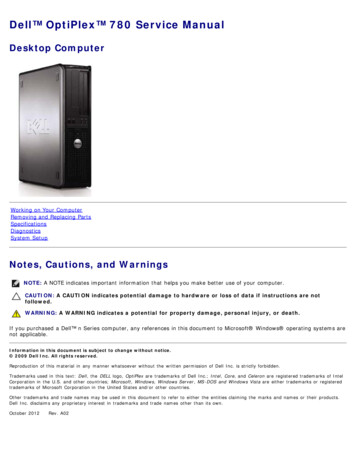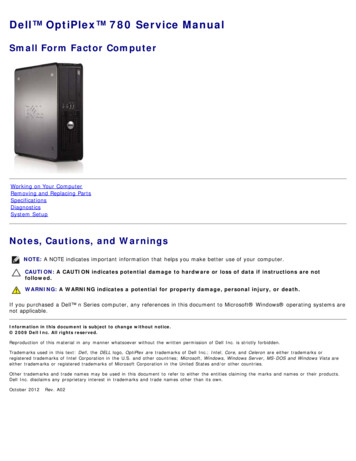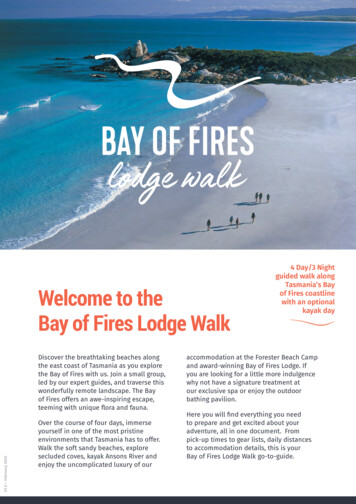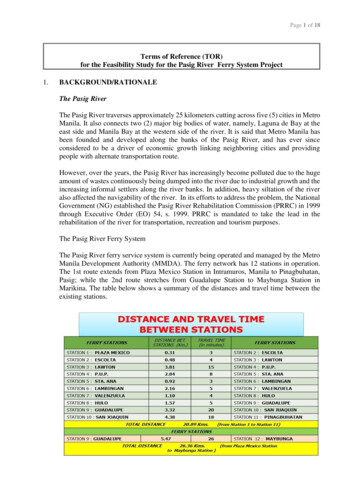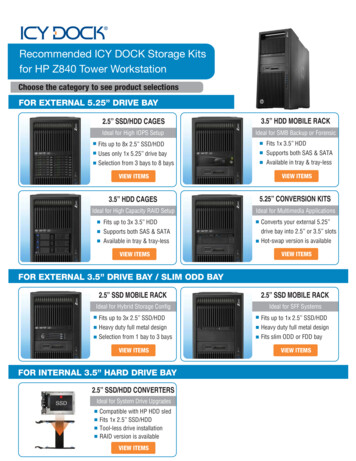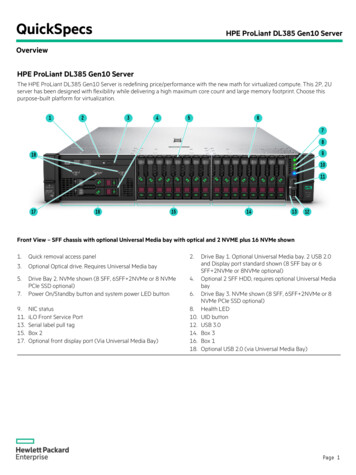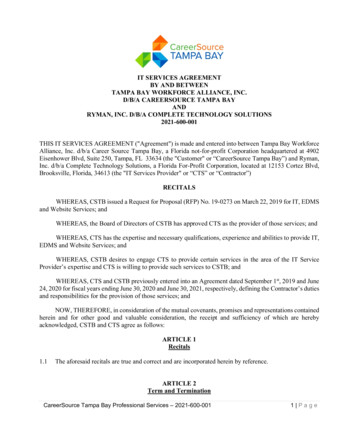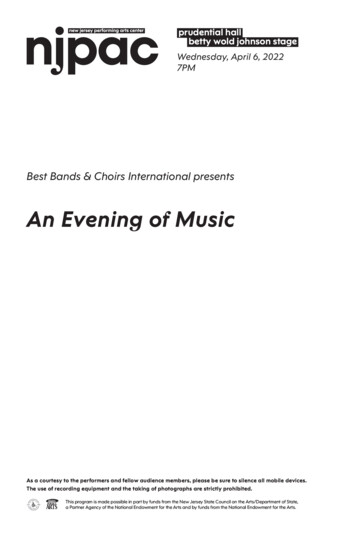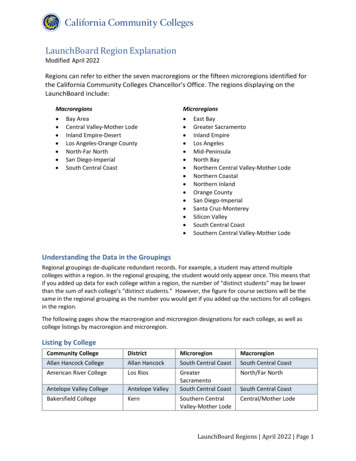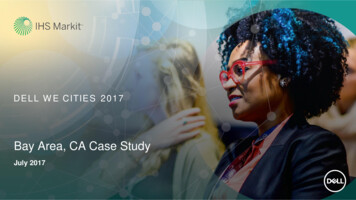
Transcription
D E L L W E C ITIE S 2 0 1 7Bay Area, CA Case StudyJuly 2017
Bay Area Case StudyCONTENTS2 of 33Dell - Internal Use - Confidential Overview & Overall Scores Notable Policies & Practices Areas of Improvement Markets Talent Capital Culture Technology Notable Bay Area Women Entrepreneurs
Overview &Overall ScoresBay Area, CA
Bay Area, CaliforniaOverall S core: 59.1 out of 100 / Overall R ank: 2 out of 50The San Francisco Bay Area encompasses the major cities of San Francisco, Oakland and San Jose.With a population of 7.65 million residents, the Bay Area is typically defined as the nine counties of Alameda, Contra Costa,Marin, Napa, San Francisco, San Mateo, Santa Clara, Solano and Sonoma.For quantitative Bay Area indicators included in the 2017 WE Cities Index, the metro region is defined as the SanFrancisco-Oakland metropolitan statistical area (MSA) and the San Jose-Sunnyvale-Santa Clara MSA.4 of 33Dell - Internal Use - Confidential
Bay Area RankingsMARKETNo. 2Policy2P o l i c y :2 1 3AccessCostA c c e s s27:Size16Cost: 253Access toQualifiedPersonnelWomen’sSkill &ExperienceSize: 95 of 33C A P I TA LNo. 1TA L E N TNo. 8Dell - Internal Use - Confidential615C U L TU R ENo. 6CapitalBase2Policy217Attitudes s toMentors/RoleModelsTE C HNo. 7Policy12Cost6Connected14
Notable Policies& PracticesBay Area, CA
Policies and Practices Impacting W omenEntrepreneurs in the Bay Area Venture Capital: The Bay Area has more VC investment, on both an aggregate and per capita basis, than anywhereelse in the world. There are more than 320 VC firms in the region and 19.1 percent of VC funds were given to BayArea businesses with at least 25 percent female executives in 2016. Access to Education: Management and technology talent is abundant, due not only to the presence of 15 businessschools, but also many coding boot camps, entrepreneurship and technology training programs and educationprograms and summer camps designed to teach relevant skills, even to young kids. Mentorship: The region has an appreciation for risk-taking and entrepreneurship. Many nonprofit and governmentorganizations, accelerators and incubators help women entrepreneurs to build their networks and scale theirbusinesses. Parental Leave: In 2016, San Francisco passed the most comprehensive parental leave law offered anywhere inthe country, with parents earning the right to six weeks of fully paid leave starting January 1, 2017, even though theUnited States is one of the few countries that provides no guaranteed cash benefits to women during maternity leave.7 of 33Dell - Internal Use - Confidential
Areas to ImproveBay Area, CA
Areas to Improv e in the Bay AreaDespite ranking as one of the greatest global cities for women entrepreneurs, the Bay Areahas room for improvement in several areas, including: Equity in Wages/Earnings: Although the Bay Area has relatively high incomes overall, Bay Area women still earnless than their male counterparts across industries. In the three Bay Area industries that offer some of the greatestopportunities for gaining relevant management or entrepreneurial experience and have the highest wages for men(management of companies and enterprises; professional, scientific, and technical services; and information), womenearn up to one-third less than their male counterparts. Employers with more than 100 employees are required todisclose a certain amount of baseline employment statistics to the U.S. Equal Employment Opportunity Commission inthe Equal Employment Opportunity report, the EEO-1. However, efforts by companies to increase transparency aboutsalaries, eliminate bias in hiring practices and disclose statistics regarding the diversity of their workforce should becontinued. Networking and Mentorship Opportunities: Women in the NWBC Bay Area Town Hall said that they “need tosupport each other more in the workplace, rather than view each other as competitors.” Mentoring or networkingprograms should be started, continued and sufficiently resourced. These same safe, open spaces for women to voicetheir concerns and find peer support might also go a long way toward bucking the Silicon Valley trend that women areleaving the tech industry at a 45 percent higher rate than men.9 of 33Dell - Internal Use - Confidential
Areas to Improv e in the Bay Area Housing costs: With housing prices and rents costing more than anywhere in the U.S. except NYC and rising amongthe fastest rates in the world, the Bay Area can be a tough place for entrepreneurs – and their employees – to makeends meet, especially in early stages of company formation or growth. The high cost of living also meansentrepreneurs have to set aside large budgets for employee compensation to attract and retain high-qualityemployees in the region’s already competitive war for talent. High housing and living costs also have longer termcompetitive repercussions: the San Jose metro area witnessed the highest level of out-migration among major U.S.metropolitan areas between 2015 and 2016. Paid parental leave: Following in San Francisco’s footsteps, other Bay Area cities might consider emulating the city’slandmark paid parental leave legislation or determining their own version of this law. This could be that femaleentrepreneurs and executives don’t have to pay a price associated with their gender – and can count on a basic sourceof capital while starting a family.10 of 33Dell - Internal Use - Confidential
MarketsBay Area, CA
Markets in the Bay Area Although the Bay Area is not the largest of the cities included in the 2017 WE Cities Index, the Bay Area’s total grossmetro product (GMP) in 2016 is nearly USD 742 billion. Behind only the U.S. metro areas of NYC and Los Angeles,the Bay Area’s economy is comparable to the size of the Holland’s and larger than Turkey’s. The three largest industry sectors in the region, by employment, are: professional, scientific, and technical services;health care and social assistance; and manufacturing. One interviewee also talked about how the industry diversity inAustin provides a lot of cross pollination for innovation, for example, between engineering and medical. The large amount of buying power in the region is also exemplified by the high salaries witnessed in the technologyand biotech sectors with regional average annual wages of more than 99,000, the highest of all U.S. metro areas. In addition to the large size of the local market, the Bay Area offers women entrepreneurs greater market access. Home to 10 of the Fortune 2016 Global 500 businesses, the Bay Area puts local women entrepreneurs in closeproximity to the headquarters of many large, multinational companies. And, further increasing market access for women-owned businesses, many Bay Area companies have corporatevendor diversity programs. For example, Apple, Wells Fargo, Chevron, Intel, and PG&E are corporate members ofWEConnect, a global network that connects women-owned businesses to qualified buyers around the world. Accelerators like Y Combinator, AngelPad and Founder Institute offer support with idea and product development,team formation, fundraising, financing, building an exit strategy and expanding customer base.12 of 33Dell - Internal Use - Confidential
Markets in the Bay Area Local government policies and programs also play a role in expanding market access for women entrepreneurs. The cities of San Francisco, Oakland and San Jose all have a website portal designed to help new businesses getstarted in the city. In 1998, the City of San Francisco became the first city in the world to adopt a local ordinance reflecting the principlesof the UN Convention on the Elimination of All Forms of Discrimination Against Women (CEDAW). Also, for twodecades beginning in 1984, the City of San Francisco had a Minority Business Enterprise/Women Business Enterprise(MBE/WBE) program that required prime contractors bidding on San Francisco contracts to either “make use of MBEand WBE subcontractors in city projects or to demonstrate good-faith efforts to provide equal opportunities to MBE andWBE subcontractors.” However, when it comes to Market Cost, the Bay Area ranks in the bottom half (the only category where it ranksin the bottom half). For corporate tax it ranks No. 47 out of 50. One interviewee did see this as a positive, though, saying “you have to bean optimist to live here,” which is a critical entrepreneurial mindset.13 of 33Dell - Internal Use - Confidential
TalentBay Area, CA
Talent in the Bay AreaWith a female working age population (ages 20 – 64) of more than two million in the BayArea, nearly three-quarters (60 percent) participate in the regional labor force, as comparedto 17 – 80 percent in other global cities in the 2017 WE Cities Index. Bay Area women aged 25 and up are a highly educated group: more than half (55 percent) have at least anassociate’s degree and 19 percent hold a graduate degree or higher, compared to the national average of 12 percent. The high levels of overall female educational attainment are also complemented by many courses designed to helpwomen learn technology skills and thrive in the high tech industry: both Girl Develop It and Women Who Code havechapters in Oakland, San Francisco and Silicon Valley; Girls in Tech (GIT) has a San Francisco chapter; Black GirlsCode has a Bay Area chapter; and there are many other technology and STEM education programs in the Bay Areadesigned for women, such as the Girls Make Games summer camps, Techbridge Girls’ after-school and summerprograms, and Hackbright Academy, an engineering school for women with a mission to “increase femalerepresentation in tech through education, mentorship and community.” Women can also learn business and management skills at any of the 15 accredited business schools in the Bay Areawhere female enrollment in MBA programs averages 45 percent. But, the ratio between women and men who hold an MBA is 0.6, meaning for every three women with an MBA thereare five men with an MBA, ranking it No. 10 among all cities in the 2017 Dell WE Cities Index.15 of 33Dell - Internal Use - Confidential
Talent in the Bay Area Bay Area women find the greatest number of employment opportunities in the following sectors: health care and socialassistance; professional, scientific and technical services; and educational services (the three largest sources offemale employment in the Bay Area). Of more than 1.5 million employed women in the region, nearly 16,900 (0.5 percent) are employed as top executives(as compared to 1.1 percent of employed Bay Area men), ranking it No. 12 on this indicator, and more than 1,500 (0.1percent) work in the industry defined as “management of companies and enterprises.” In addition to having a large number of highly educated and experienced businesswomen and entrepreneurs, the BayArea also offers women entrepreneurs access to a significant talent pool of diverse, highly educated andqualified professionals. More than half of the Bay Area population has at least an Associate’s degree, the ranking No. 8 for highest tertiaryeducational attainment rate in the 2017 Dell WE Cities Index.16 of 33Dell - Internal Use - Confidential
Talent in the Bay Area The Bay Area’s highly educated workforce is in part due to the presence of four of world’s 1000 best global universities(as evaluated by the U.S. News & World Report in 2017): Stanford University, University of California, Berkeley,University of California, San Francisco, and San Francisco State University. Despite the vast pool of talented people, there is often intense competition for talent that makes it difficult forentrepreneurs to recruit and retain specialists in some fields. In the Bay Area people tend to want to work for startups and can work in startups because of the abundance in thearea. Our interviews found that this is not the case everywhere, and also that working for a startup is a differentmindset than working in an established company where processes are traditionally better defined and there is moreorganizational structure and pay structure. The diversity of the workforce contributes to diversity of thinking in the Bay Area. One-third of Bay Area residents were born in other countries and, in recent years, the San Francisco-Oakland-HaywardMSA has one of the highest net domestic in-migration rates (the difference between people arriving in the area andthose moving away) among all U.S. metro regions. One interviewee expressed that having this diversity allows forinnovation.17 of 33Dell - Internal Use - Confidential
CapitalBay Area, CA
CapitalFor women entrepreneurs, access to capital depends on three main things: the total pool of investmentfunds available, women-owned businesses’ ability to garner their fair share of the available funds andwomen’s ability to build their capital base.Focused on sheer numbers, the Bay Area is the best in the world. The Bay Area ranks No. 1 for: the most active corporate VC firms, the value of VC funds given to businesses with atleast 25 percent female executives and the number of VC firms with greater than 25 percent female partners. The area ranks No. 2 for the number of women-founded VC firms. Bay Area investors, as compared with investors with financial services backgrounds, are more likely to have hadexperience launching startups themselves. However, this can create a bias in the types of companies that getinvestment dollars. At least one interviewee in the Bay Area said that it was difficult to raise VC funding in the Bay Area if you are not in thetech or biotech industry.19 of 33Dell - Internal Use - Confidential
Capital in the Bay Area The availability of capital doesn’t tell the whole story. Despite the fact that venture capital for women entrepreneurs ismore abundant in the Bay Area than in other regions, at a 2016 roundtable event for high growth women entrepreneurshosted by the National Women’s Business Council (NWBC), participants noted several challenges associated withraising capital as a woman entrepreneur in Silicon Valley. Among the challenges are the intense time requirements for CEOs during fundraising periods that make it “verydifficult to meet the 100-hour-a-week requirements of work while still finding time for family.” However, the Bay Area has improved in gender proportion of funding and ranks No. 10 for the percent of businesseswith a woman founder or executive in a second funding round or higher. Examining gender ratios in later-stage VC funding rounds is important because it highlights the inequalities in thepractice. However, VC is only one source of funding. Entrepreneurs also finance their businesses through personal savings,loans from family or friends, crowdfunding or loans from banks (often secured with a personal residence). With high average annual incomes and some of the world’s most active crowdfunding sites, aspiring womenentrepreneurs in the Bay Area have significant opportunities to raise capital.20 of 33Dell - Internal Use - Confidential
Capital in the Bay Area However, the Bay Area’s No. 6 rank in terms of the number of high net worth individuals (potential investors) might berelated to the fact that the Bay Area’s high cost of living inhibits people with high incomes from building wealth as quicklyas they otherwise could. The No. 6 rank could also be tied to the fact that women in the Bay Area earn less than men, including in technologyjobs where they make about 9,000 less annually than their male counterparts. (Note that this is despite the fact thatCalifornia has the strongest equal pay protections in the U.S. and San Francisco’s new paid parental leave laws expandCalifornia's paid family leave law to provide new parents that work for businesses and nonprofits with 50 or moreworkers with 100 percent of their wages for up to six weeks). Bay Area policies such as these directly help women maintain income continuity during the early days of parenthoodand can help level the playing field for women with regard to future wages, job opportunities and earnings potential.21 of 33Dell - Internal Use - Confidential
CultureBay Area, CA
CultureThere is often consensus among female entrepreneurs and CEOs about the value of having a supportnetwork of people who understand the challenges that they face, can be a sounding board as theycontemplate big decisions, and can serve as mentors and friends. In the Bay Area, there are many networksdesigned for this very reason, comprised of both males and females. Networks in the Bay Area include: Astra’s Northern California Leadership Forum (a regional partner organization of theWomen’s Business Enterprise National Council - WBENC), Astia, AnewAmerica’s Women’s Business Centers indowntown Oakland and San Jose, NAWBO San Francisco Bay Area and NAWBO Silicon Valley, the Women’sNetwork run by the Renaissance Entrepreneurship Center, Women’s Startup Lab, and those housed at Bay Areauniversities and business schools such as the Berkeley Entrepreneurs Association or the Stanford Venture Studio. The NWBC’s February 2016 Bay Area Town Hall Summary Report explains: “The mere fact that there are so manyentrepreneurs concentrated in the Bay Area means that it is easier to network and be exposed to new ideas andopportunities than in many communities.” Many interviewees from the Bay Area expressed the value of the community and how the smaller geographic areacombined with a high concentration of entrepreneurs allows people to “bump into” people that can be helpful.23 of 33Dell - Internal Use - Confidential
Culture in the Bay Area One of the unique characteristics of the region’s female entrepreneurial ecosystem, noted by the women who wereconvened by NWBC in January 2016, was the Bay Area’s entrepreneurial mindset. One participant described this mindset as a “freethinking, Wild West, not-afraid-to-fail spirit.” The region has aninfatuation with disruptive technologies and willingness to try new things. Our interviewees also expressed the positivevibe where people think things are possible and that creates a lot energy for startups. However, this same innovative and entrepreneurial environment that has been cultivated by the Bay Area tech industryhas been criticized for its “bro” or “brogrammer” culture. In fact, sexism and harassment continue to be major problems for local women entrepreneurs and the 2015 Elephant inthe Valley survey of 210 women (91 percent living in Silicon Valley) revealed, among many other disturbing facts, that: 90 percent witnessed sexist behavior at company off-sites and/or industry conferences 88 percent have experienced clients/colleagues address questions to male peers that should havebeen addressed to them 84 percent have been told they are too aggressive (with half hearing that on multiple occasions) 59 percent have felt they have not had the same opportunities as their male counterparts 47 percent were asked to do lower-level tasks that male colleagues were not asked to do 1 in 3 have felt afraid of their personal safety because of work related circumstances24 of 33Dell - Internal Use - Confidential
Culture in the Bay Area These kinds of discriminatory behaviors against women in the Bay Area have been brought to the forefront by the 2012gender discrimination lawsuit Ellen Pao filed against her previous employer, Kleiner Perkins Caufield & Byers (one ofSilicon Valley’s most well-known venture capital firms); the 2015 class action gender discrimination suit filed againstTwitter by former engineer Tina Huang; the gender discrimination, harassment and retaliation lawsuit filed againstFacebook by former employee Chia Hong the same year; and the highly publicized February 2017 blog post by formerUber engineer, Susan Fowler, chronicling the discrimination and misogynistic atmosphere she experienced whileworking at the company. While our interviewees say there is now an awareness about unconscious bias, there is still more “talk than action.” Further, as in the rest of the U.S., which is the only industrialized country without national legislation entitling women topaid maternity leave, Bay Area women entrepreneurs also feel that the business culture is often not supportive offamilies and there is a strong need to improve child care in the U.S.25 of 33Dell - Internal Use - Confidential
TechnologyBay Area, CA
Technology in the Bay Area Silicon Valley houses the headquarters of some of the most well-known tech companies, including Facebook, Google,Apple, Intel, Yahoo, eBay and Cisco. The southern portion of the Bay Area (in the Santa Clara Valley that includes the city of San Jose and surroundingcities and towns) is known as Silicon Valley due to the large number of silicon chip innovators and manufacturers in thearea. Since the 1950s, Stanford has played a critical role as an incubator of technology by funding student research, hiringtop engineers and scientists to serve as faculty, building the Stanford Research Park, and encouragingentrepreneurship and collaboration with industry. Places refer to themselves as the “next Silicon Valley” when they strive to become a hotbed of technology innovation.27 of 33Dell - Internal Use - Confidential
Technology in the Bay Area Though the Bay Area ties for the No. 1 rank in the proportion of women to men that use the internet and in theproportion of women with smart phones, it ranks No. 23 for gender equality in LinkedIn use. Despite being a hub of tech innovation, it ranks No. 21 for the number of smart city projects, which can help to betterconnect people with the physical world, improve transparency and inspire further innovation. Realizing the importance of technology in regional competitiveness, local governments have begun to implementpolicies to improve technology quality, improve access and decrease cost. For example, in 2015 the San Francisco citygovernment released the city’s first Connectivity Plan, which is an important component of its new five-year overalltechnology plan. Mayor Ed Lee notes, “The Connectivity Plan is the city’s first step in developing a strategy to help narrow the digitaldivide and support the next generation of job creators.” Other local government investments that help the Bay Area in the technology Policy subcategory include an open dataportal that makes public data transparent and numerous opportunities for women to get technology training. However, Bay Area governments could do more to ensure that gender-based disparities in technology utilization arequickly identified and rectified by collecting data on the local use of technology by gender, which few cities do today.28 of 33Dell - Internal Use - Confidential
Bay Area WomenEntrepreneursBay Area, CA
AMY NORMANCo-Founder and Co-CEO,Little PassportsLittle Passports is a company that develops innovative products and experiencesthat inspire children to learn about the world and become young global citizens.Background: Amy Norman is the co-founder and co-CEO of Little Passports, Inc.,a children's media company inspiring children to learn about the world. Launchedin 2009, the company has four innovative subscriptions that introduce children tothe world around them via monthly postal packages and online games. Amy is aseasoned leader with over 20 years of experience in general management,strategy, and finance. Amy gained her operating experience at eBay having spenther early career focusing on finance and strategy, both at McKinsey and earlier asa CPA. She’s also a member of Small and Medium Business Council at Facebookand a contributor at Forbes.Recent coverage: She Was Pregnant. Her Marriage Was Ending. And She Was Bootstrapping A Non-TechCompany In SF – Forbes Small Business Snapshot: Little Passports – Business News Daily Women in Business Q&A: Amy Norman, Co-Founder and Co-CEO, Little Passports –Huffington Post30 of 33Dell - Internal Use - Confidential
ROSE BROOMECo-Founder and CEO,HandUpHandUp is a fundraising platform for nonprofits focused on poverty. HandUp’s 100nonprofit customers located across the San Francisco Bay Area, Detroit, and SaltLake City have raised over 2M on the platform to date. Donations go towardbasics like housing and medical care with transparency and updates to donors.Background: Rose Broome is passionate about using the power of technology tocreate social change. She came up with HandUp after passing a woman sleepingon the street in the winter of 2012 and wanting to see a new way to give.Previously, Rose served as COO at SuperBetter Labs and as a Data Manager forBarack Obama's 2008 presidential campaign. Rose loves organizing thecommunity and has been active in groups like Science Hack Day and Food NotBombs. In 2015, HandUp won the Webby Award for Best Charity People’s Voiceand Rose was listed in the Top 100 People in Tech by Business Insider.Recent coverage: Tech tackling homelessness Bullish – TechCrunch Rose Broome uses crowdfunding to offer hope to homeless – SFGate Apps I Live By: HandUp Founder & CEO Rose Broome – NBC News31 of 33Dell - Internal Use - Confidential
DANAERINGELMANNFounder and ChiefDevelopment Officer, IndiegogoIndiegogo is the global platform for entrepreneurs to bring their ideas fromconcept to market"Background: Danae is one of the founders of Indiegogo. After both witnessing herparents struggle to find capital for their business and failing to help severalindependent artists finance their independent projects, she quit her day job infinance to develop a business idea that would address the inequities andinefficiencies in funding by democratizing access to capital. A year later, Danaelaunched Indiegogo with her two co-founders, Slava Rubin and Eric Schell. Danaehas been listed as one of Fortune Magazine’s 40 under 40, and a Young GlobalLeader by the World Economic Forum. Prior to starting Indiegogo, Danae workedin equity research and corporate finance at Cowen & Co, and JPMorgan. Sheholds a BA in Pre-Med and American Studies from University of North Carolinaand an MBA from University of California, BerkeleyRecent coverage: How To Boss It Like Danae Ringelmann, founder Indiegogo - The Memo The Gogo factor: how to make your fortune through crowdfunding - Wired.co.uk Indiegogo’s founder was rejected 90 times—here's how she bounced back - CNBC32 of 33Dell - Internal Use - Confidential
33 of 33Dell - Internal Use - Confidential
The San Francisco Bay Area encompasses the major cities of San Francisco, Oakland and San Jose. . where female enrollment in MBA programs averages 45 percent. But, the ratio between women and men who hold an MBA is 0.6, meaning for every three women with an MBA there . University of California, San Francisco, and San Francisco State .

